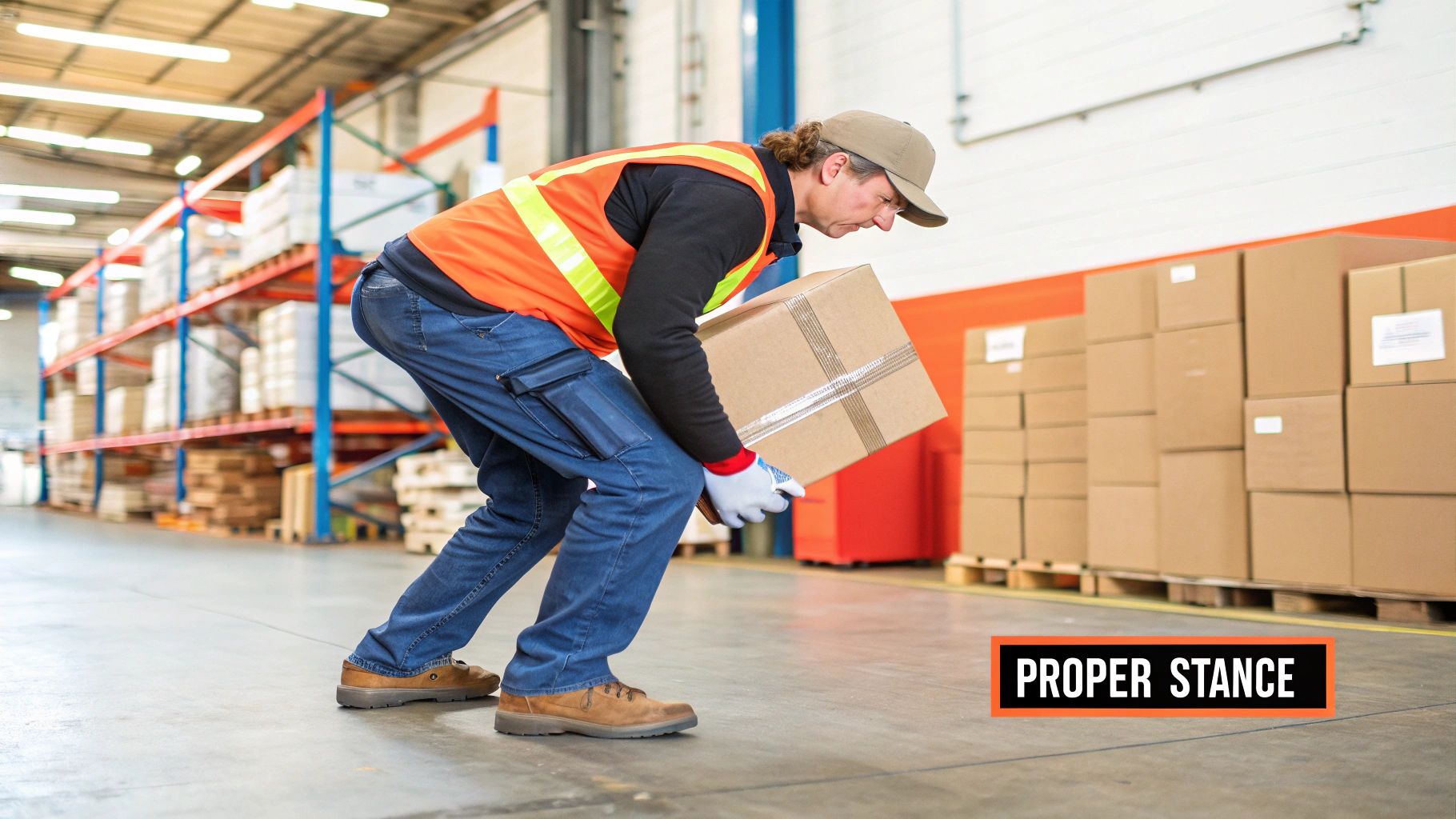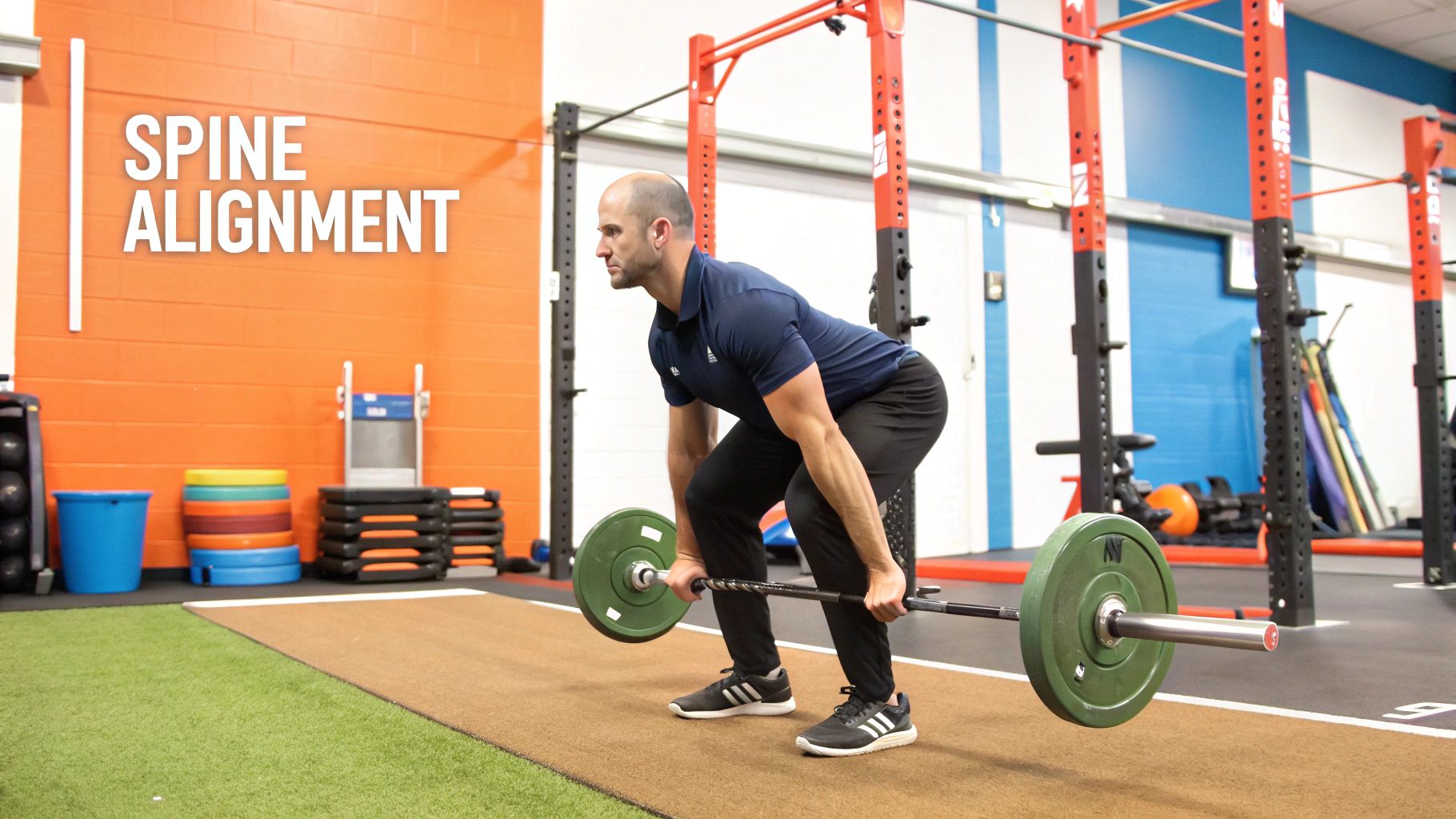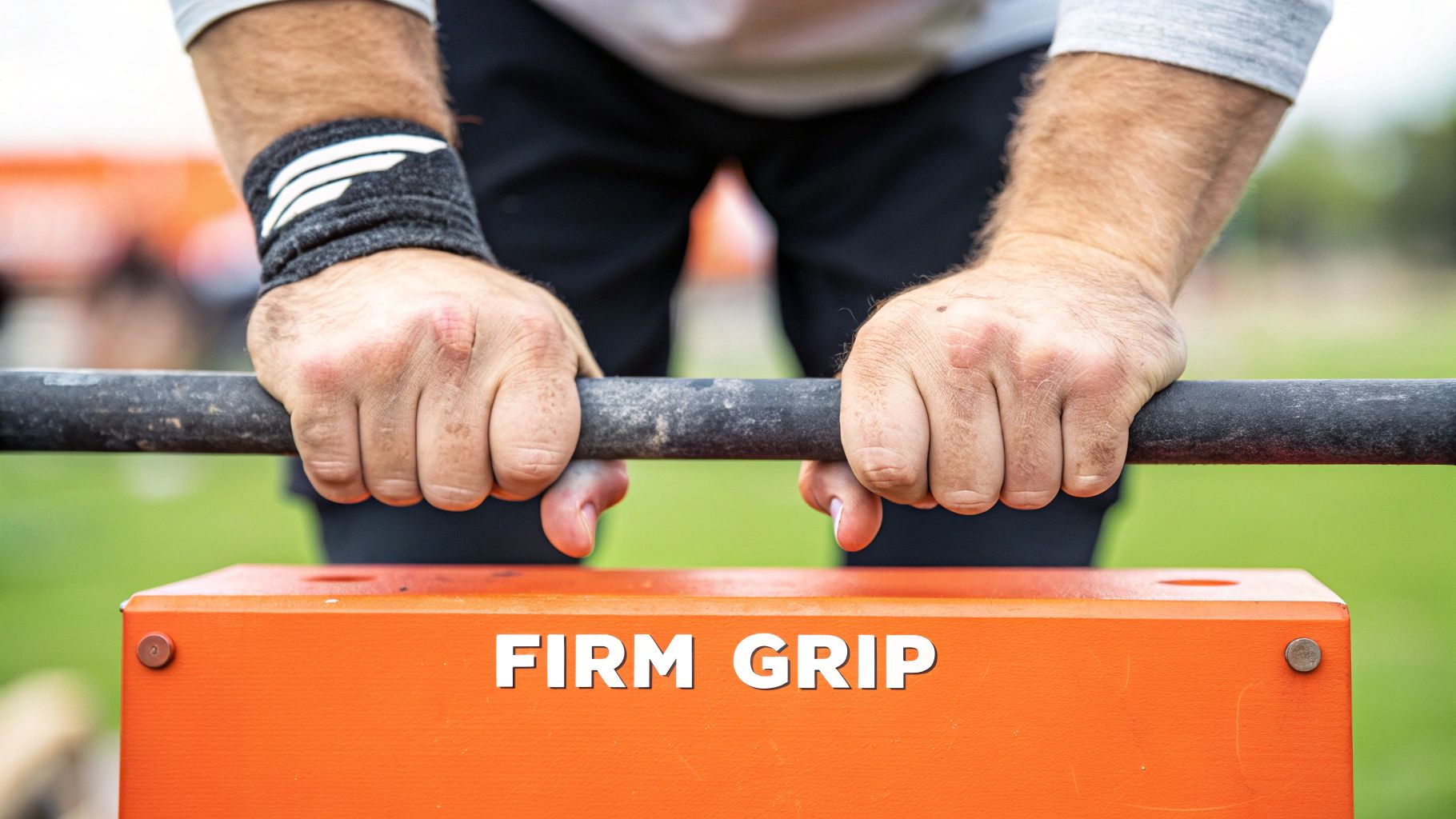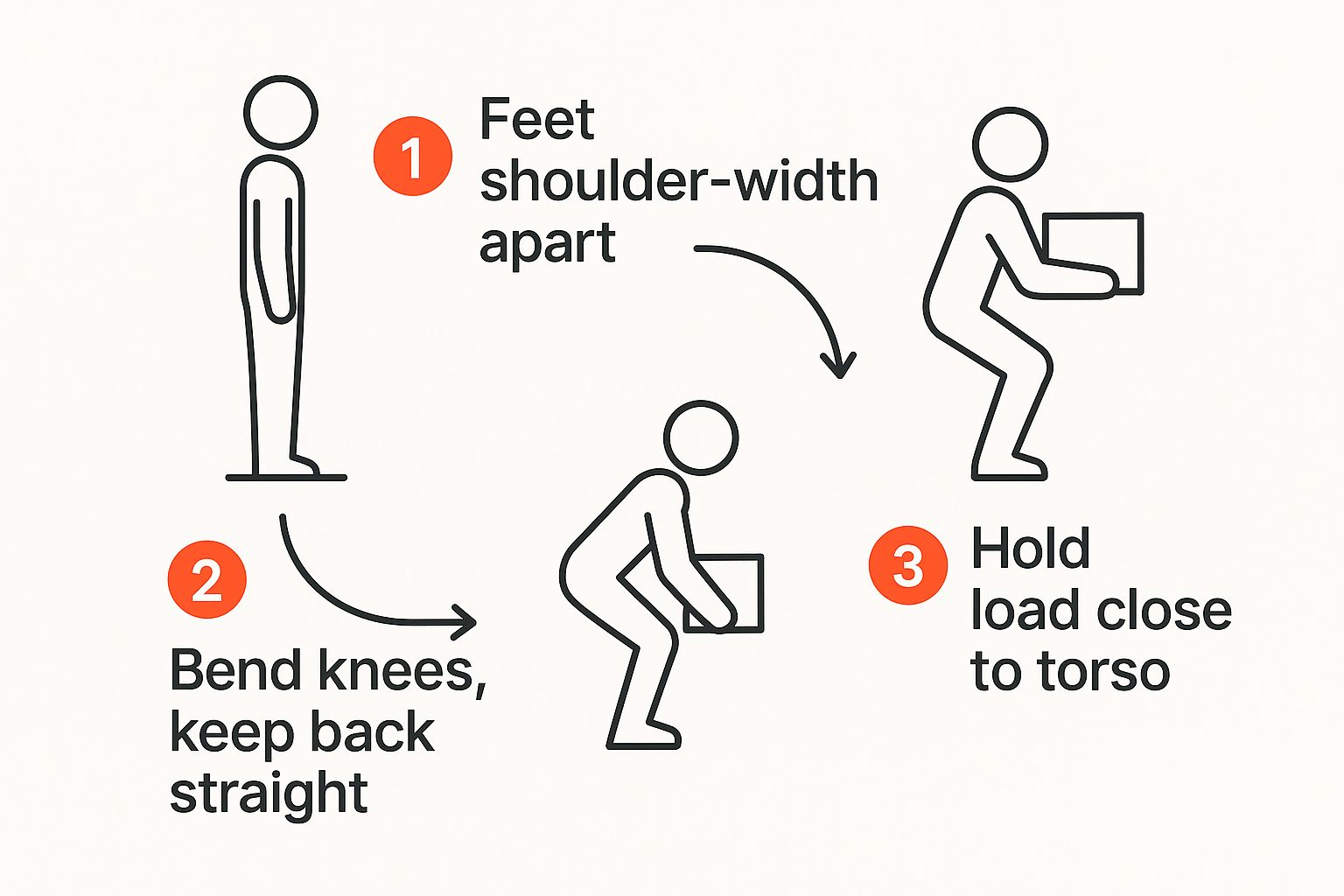-
CALL US:
- (866) 952-3456
You know that little twinge you feel after hauling in the groceries or moving a cardboard box? It’s easy to shrug off, but it’s often your body’s first warning sign. Honestly, learning how to lift things properly isn't just for powerlifters or warehouse workers; it's a fundamental skill everyone needs to avoid unnecessary pain.

It’s a common misconception that back injuries are only caused by major accidents or seriously heavy labor. The reality I've seen over and over is that most spinal problems start small. They build up over time from doing simple, everyday things the wrong way—picking up a toddler, rearranging the living room, or even carrying a full laundry basket.
This guide isn't about teaching you complex gym exercises. It's about making small, impactful changes to how you lift things in your day-to-day life. These are real-world techniques that will help you protect your back and avoid becoming just another statistic.
Poor lifting habits can have some serious consequences. In the workplace alone, over one million back injuries are reported each year, making up roughly one in every five of all on-the-job injuries. And it's not just the back; these incidents, usually born from bad technique, frequently affect the shoulders and neck, too.
The most dangerous lift is the one you underestimate. A single moment of carelessness can lead to weeks or even months of painful recovery, affecting your work, hobbies, and overall quality of life.
A deeper look into workplace safety standards, like the official OSHA safety training requirements, really drives home just how critical proper lifting form is.
Before you lift, quickly run through these core principles. Think of this as your pre-lift mental check to ensure you're ready to go.
| Principle | Why It Matters for Your Safety |
|---|---|
| Get a Firm Stance | A wide, stable base prevents you from tipping over and allows you to use your leg strength effectively. |
| Squat, Don't Bend | Bending at the waist puts all the strain on your lower back. Squatting engages your powerful leg and glute muscles. |
| Keep It Close | Holding the item close to your body’s center of gravity reduces the leverage and strain on your spine. |
| Lift with Your Legs | Your legs are the strongest muscles in your body. Drive the lift upwards with them, not by pulling with your back. |
| Don't Twist | Twisting while lifting is one of the most common ways to injure your back. Move your feet to turn your body instead. |
This checklist isn't just for big moves; it's for any lift where you feel a bit of strain.
The end goal here is to make safe lifting second nature, just like putting on your seatbelt. When you train yourself to automatically use your strong leg and core muscles, you take the load off your delicate spine. This core idea is the same whether you're lifting a 10-pound bag of dog food or figuring out https://assemblysmart.com/easy-ways-to-move-heavy-furniture/ in your house.
Making these simple tweaks can genuinely prevent a lifetime of chronic pain, helping you stay active and self-sufficient for many years.

A successful lift doesn't start when you grab the box. It starts with the prep work you do beforehand. I've seen it countless times—someone rushes in, tries to manhandle a heavy object, and ends up with a pulled muscle or worse. Taking a minute to think things through is the smartest thing you can do.
First, get a sense of what you're up against. Don't just eyeball the weight. Consider the item's shape and how stable it is. A dense, sealed box is one thing, but a tall, wobbly floor lamp or a potted plant with shifting soil is a completely different beast.
Here's a little trick I always use: give the object a gentle test push or a slight tilt with your foot. This gives you a real feel for the actual weight and stability without committing to the full lift. It’s a quick and safe way to avoid any nasty surprises.
Once you know what you’re dealing with, it’s time to map out your journey from point A to point B. A clear path is absolutely essential.
Scan your entire route for anything that could trip you up. It's amazing what we overlook in our own homes. Keep an eye out for these common culprits:
What you wear matters, too. You need comfortable clothing that allows you to move freely—nothing too restrictive. Most importantly, wear sturdy shoes with non-slip soles. Good traction is your best friend when moving something heavy.
Before you even think about lifting, you need a solid foundation. If you have a history of wobbly ankles, it’s worth looking into methods for maintaining ankle stability to prevent a roll.
Finally, give your body a quick warm-up. Just 30 seconds of dynamic stretches can make a huge difference. Gentle leg swings and torso twists get the blood flowing and prime your muscles for the work, significantly cutting down your risk of a strain.

We've all heard the old saying, "lift with your legs, not your back." While that's a decent starting point, it only tells part of the story. To really protect your spine and lift with genuine power, you need to set up a solid foundation before you even touch the object. This all starts with what I call the power stance.
Think about how an experienced weightlifter sets up for a heavy deadlift. They create an unshakeable base. That's exactly what you're aiming for. Start by planting your feet about shoulder-width apart. This gives you a wide, stable platform and prevents you from teetering side-to-side.
Now for a pro tip: stagger your stance. Put one foot slightly in front of the other. This small tweak makes a huge difference in your front-to-back stability, which is essential once you start moving with a heavy or awkward item. You've just created a powerful base to drive from.
One of the biggest mistakes I see people make is trying to lift something that's too far away from them. You want to get as close as physically possible. If the object allows, straddle the load by placing it directly between your feet. This brings the weight right into your body's center of gravity.
The closer an object is to your core, the less leverage it has against your back. This simple adjustment can make something feel dramatically lighter and puts the strain on your powerful leg muscles, not your vulnerable spine.
This is a core principle behind the Powerlift™ method. In fact, one study found that using this technique led to a 17% decrease in spinal compression compared to other common lifting styles. The main reason? Straddling the load helps you stay stable and keep your back straight. You can learn more about the research behind Powerlift™ safe lifting techniques on powerlifttraining.com.
With your feet set and the object nestled in close, all that's left is to perfect your posture. Keep your back straight—think "proud chest." Pull your shoulders back and look forward, not down. This posture automatically engages your core and legs, prepping them to take on the load.
Alright, you've sized up the item, cleared your path, and found your footing. Now comes the part where all that prep work pays off. This is where you turn a potentially back-breaking task into a controlled, safe movement. The golden rule, the one you absolutely cannot forget, is to let your legs do the heavy lifting.
Think of it like sitting down in a chair that isn't there. You'll want to lower yourself by bending at your hips and knees, not your waist. Keep your back straight, your chest out, and your head up. Your spine should stay in a nice, neutral line from your neck down to your tailbone.
Once you're in that squatting position, it's time to grab on. A firm, confident grip is non-negotiable here. Don't just pinch it with your fingertips—that’s asking for trouble. Get the palms of your hands right up against the item and wrap your fingers securely around it. If you're dealing with something awkward like a handle-less box, slide your hands underneath to get the best possible purchase.
A full-palm grip isn't just about holding on; it's about control. It engages your entire hand and forearm, giving you way more stability than a fingertip grip. This is the difference between fumbling with an object and truly commanding it.
Take a beat. Feel the weight in your hands. Is it balanced? Does it feel secure? Don't even think about standing up until you can answer "yes" to both.
This simple visual breaks down the key steps for a safe lift.

Seeing the process laid out like this—from the wide stance to keeping the load close—is a great way to build the right muscle memory.
Ready to lift? Tighten your core muscles and drive straight up. The power should come from pushing through your heels as you straighten your legs. I always tell people to imagine they're pushing the floor away from them. This simple mental trick ensures your quads and glutes, your body's powerhouses, are doing all the work.
As you rise, keep the item tucked in close to your body. The further it gets from your torso, the more strain you put on your lower back.
Putting it down is just as important. Don't just get to your destination and drop it. Reverse the entire process. Lower the item by squatting down with the same controlled movement you used to lift it. A controlled descent is essential, especially when you need to protect furniture when moving and want to avoid scuffing your floors or damaging the piece itself.
So, you've successfully lifted the heavy object off the floor. That’s a great start, but don't get complacent. This next part—actually moving with the weight—is where a lot of people get hurt.
The absolute golden rule once you're upright is to never twist your spine. I can't stress this enough. Twisting while loaded is probably the fastest way to end up with a debilitating back injury.
If you need to turn a corner or change direction, move your feet. Take small, deliberate shuffling steps to pivot your entire body as one solid unit. Your shoulders and hips should always stay aligned. Think of yourself as a tank turret, not a bendy straw.
Even with the best form, it’s surprisingly easy to slip into old, bad habits, especially when you're tired. The key is to catch yourself in the act and make an immediate correction. Here are the most common mistakes I see people make:
The Jerky Lift: This happens when you try to use momentum to get the object moving. That sudden, jerky motion sends a shockwave of uncontrolled force right through your muscles and spine. If you feel yourself doing this, stop. Put the item down, take a breath, and restart the lift with a smooth, steady push from your legs.
Forgetting to Breathe: It's a natural instinct to hold your breath when you strain, but it's a bad one. It skyrockets your blood pressure and robs your muscles of the oxygen they desperately need. Make a conscious effort to exhale on the lift (the hard part) and inhale as you lower the object.
Bending From the Waist: Take a quick glance down. Is your back rounded like a C? If so, you're using your back, not your legs. Immediately bend your knees more and straighten your back, forcing your powerful leg muscles to take over the load.
The real goal here is to build muscle memory until the right way feels like the only way. A smooth, controlled movement is always safer than a fast, sloppy one. Keep your eyes up, watch where you're going, and take small, careful steps.
Some items, like those notoriously long and awkward flat-pack boxes, are just a pain to handle alone. For bigger projects, it's often smarter (and safer) to call in a professional. Investing in an expert for your IKEA furniture assembly can save you from the risk of injury that comes with wrestling those heavy pieces around.
Even when you know the rules, real-world lifting can throw you a curveball. Let's tackle some of the most common questions that pop up when you're staring down a heavy or awkward object.
Honestly, your first instinct is usually right. Before you commit to the full lift, give the item a little test nudge. If you have to strain just to tilt it, or if it feels like a monumental effort to even get it slightly off the ground, stop right there.
Another dead giveaway is your form. If you find yourself unable to keep your back straight and chest up as you begin the lift, that’s your body telling you the load is too great. A moment of ego isn't worth weeks of back pain. It’s always smarter to grab a friend or a dolly.
We've all been there—a giant bag of dog food, a round decorative planter, or an unboxed microwave. When there are no convenient handles, your goal is to create a stable, secure grip. The main idea is still to get the object as close to your core as possible.
You see them all the time on warehouse workers, but for a one-off move at home, a back belt can give you a false sense of security. It’s not a magic shield. A belt won't add to your strength, and it certainly won't protect you if you use bad technique.
Think of a back belt more as a physical reminder to tighten your core muscles and lift properly. For occasional household lifting, your time is much better spent mastering safe lifting techniques than relying on a belt for protection.
When safety is made a priority, the results speak for themselves. One study found that implementing a strong safety culture led to a 69% decrease in sprains, strains, and back injuries across multiple facilities, which you can read more about on kmilearning.com. For big, complicated items, the smartest and safest move is often to call in a pro. Getting professional furniture assembly help you can trust takes the risk completely off your shoulders.
Don't risk injury or frustration with confusing instructions. Let the professionals at Assembly Smart handle the heavy lifting and complex assembly for you. From bedroom furniture to outdoor playsets, we build it right so you can enjoy it sooner. Book your stress-free assembly today!